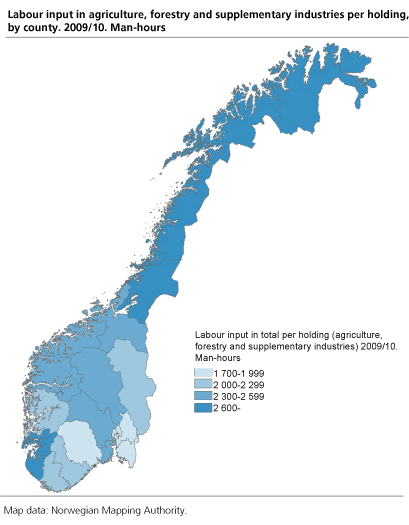Content
Published:
This is an archived release.
Strong decrease in labour input to agriculture
Labour input to agriculture has fallen by a third since 1999. In parallel with a considerable reduction in the number of holdings, labour input was reduced from 80 800 man-years to 53 300 man-years. Hiring of services from self-employed entrepreneurs and other farmers increased.
The first preliminary figures from the census, which was conducted last summer, reflect a strong decrease in labour input. Larger holdings, more rational farming and an increased specialisation are some of the reasons for the decline. Despite the fall in labour input, the production level has remained stable. However, meat production has changed from cattle to pig and poultry, and milk production has fallen, whereas the production of grain and potatoes remained almost unchanged.
Rented labour input has increased. In 1999, three out of four man-hours were conducted by farmer and spouse. In 2010 the proportion was reduced to two out of three man-hours. Family members still performed 10 per cent of the labour input, while the share of hired labour increased from 13 to 26 per cent. Of the total hired labour input, other farmers and self-employed entrepreneurs conducted 1 740 man-years in 2010.
The decrease of labour input was largest in the counties of Hordaland, Sogn og Fjordane and Møre og Romsdal, with a fall of about 40 per cent. The least decrease was recorded in the counties of Buskerud, Vestfold and Rogaland. The highest labour input is in Rogaland and Oppland, where animal husbandry is strong.
Average labour input in agriculture per holding was 2 162 man-hours; about the same as in 1999.
Other gainful activities
In 2010, almost 60 per cent of the holdings performed other gainful activities based on holding resources (machinery, buildings, area or products/raw materials), compared to slightly more than 40 per cent in 1999. Almost 11 000 holdings performed contracting work with tractors, combine harvesters etc. in 2010. A total of 10 000 rented out fishing and/or hunting rights. The recent cold winters may have led to more holdings cutting firewood for sale.
In total, about 4 000 man-years were spent on other gainful activities.
Drainage and irrigation
Forty-seven per cent of the holdings reported that at least parts of the agricultural area ought to be drained. In total, 840 000 decares need drainage, representing 8 per cent of all agricultural area in use.
A total of 7 400 holdings have irrigation equipment that can be used on about 1 million decares; about the same as in 1999.
Tables
- Table 1 Labour input in agriculture, forestry and other gainful activities (supplementary industries) on holdings, by county. 1 000 man-hours. 1998/99 and 2009/10
- Table 2 Labour input in agriculture, by category of manpower and county. 1 000 man-hours. 1998/99 and 2009/10
- Table 3 Holdings with other gainful activities (supplementary industry), by county. 1998/99 and 2009/10
- Table 4 Holdings with agricultural area with bad drainage, and holdings and area that can be irrigated. 1999 and 2010
More resultsOpen and readClose
The number of holdings, animal husbandry and usage of agricultural area, is given in a separate article.
The first results are based on a sample of holdings that have forwarded information. The last deadline for reporting was 1 December, and Statistics Norway was very early with the first estimates. More detailed results at municipality level will be published in 2011. Results from registers will be merged to questionnaires as soon as the registers are available.
Contact
-
Cathrine Gran Øverby
E-mail: cathrine.overby@ssb.no
tel.: (+47) 40 85 46 03
-
Berit Bjørlo
E-mail: berit.bjorlo@ssb.no
tel.: (+47) 40 81 13 76

